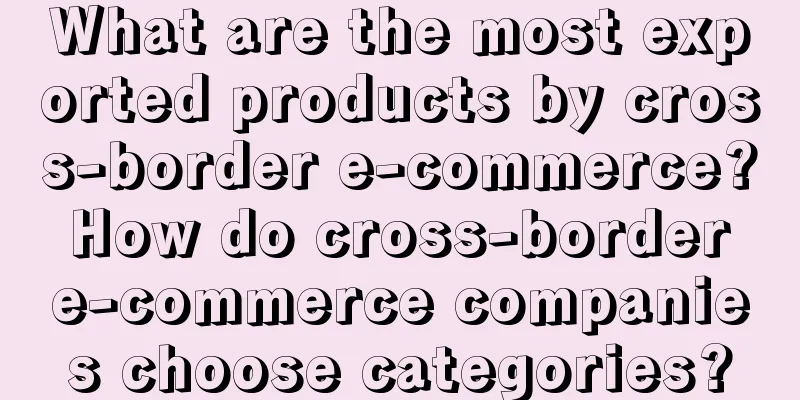What are the cross-border e-commerce logistics? Introduction to the four major models

|
I believe everyone knows how popular the cross-border e-commerce industry is now. If you are interested, you can also engage in the cross-border e-commerce industry. When there are orders on the cross-border e-commerce platform store, there will be a need for logistics support. So what are the cross-border e-commerce logistics? What are the cross-border e-commerce logistics ? 1. The first postal parcel model The postal parcel model uses personal parcels for delivery. Among international postal parcels, currently 70% of China's cross-border logistics are sent via postal parcels, of which China Post accounts for 50%. Postal logistics includes China Post Small Parcel, China Post Large Parcel, Hong Kong Post Small Parcel, EMS, International e-Postal Parcel, Singapore Small Parcel, Swiss Post Small Parcel, etc. Among them, Postal Small Parcel, International e-Postal Parcel and EMS are the most commonly used. The postal parcel mode is relatively cheap, but its disadvantages are slow delivery speed and high loss rate. 2. The second mode is international express delivery The timeliness of international express delivery is guaranteed, which makes it convenient for consumers to check real-time logistics information and has a low package loss rate. There are three types of logistics in international express delivery: air, sea and rail: 1. International air transport line refers to a dedicated route from domestic to a certain country. It is a door-to-door transportation service that includes delivery and tax. In addition to the higher cost, it is a more suitable way to prepare goods for quick sales and quick replenishment. 2. Ocean freight is a low-cost, long-term transportation method that is more suitable for large-volume cross-border logistics. 3. The railway dedicated line is mainly aimed at cross-border trade between China and Europe. The price is better than the international air transport dedicated line, but it is severely restricted by the transportation area. 3. The third type is the domestic express delivery model Domestic express delivery mainly refers to EMS, SF Express and "Sitong Yida". In terms of cross-border logistics, SF Express's international business is more mature. It has opened express delivery services to the United States, Australia, South Korea, Japan, Singapore, Malaysia, Thailand, Vietnam and other countries. Express shipments to Asian countries can generally be delivered within 2-3 days. Among domestic express delivery companies, EMS has the most complete international business. Relying on postal channels, EMS can directly reach more than 60 countries around the world. The cost is lower than that of the four major express delivery giants. The customs clearance capability in China is very strong. It takes 2-3 days to reach Asian countries and about 5-7 days to Europe and the United States. 4. The fourth model is the overseas warehousing model Overseas warehouses refer to storage facilities established by enterprises overseas. In cross-border trade and cross-border e-commerce sales, the role of overseas warehouses is that domestic enterprises transport goods to target market countries through international transportation, and establish warehouses in local areas by leasing or self-building. They are used to store goods, and then respond to local sales orders as soon as possible, and sort, pack and deliver directly from local warehouses in a timely manner. This reduces repeated and complicated customs clearance steps. So, which products are suitable for the overseas warehouse model? Let’s take a look: (1) Products with large size and weight: Since these products are limited by the specifications of small packages and dedicated mail, and the cost of international express delivery is very expensive, using overseas warehouses will break through the product specification restrictions and reduce logistics costs. (2) Products with high unit prices and gross profits: High-quality overseas warehouse service providers can control the breakage rate and lost item rate to a very low level, reducing the risks for sellers of high-value goods. (3) High turnover rate of goods: This is what we often call best-selling products. For best-selling products, sellers can process orders more quickly through overseas warehouses and recover funds; for slow-moving products, they will not only occupy funds but also incur corresponding storage fees. Therefore, in comparison, goods with high turnover rates are more suitable for using overseas warehouses. The above are several models and characteristics of cross-border e-commerce logistics. Cross-border sellers can choose a cross-border logistics model that suits them according to their actual situation. In addition to understanding the logistics model, there are many other aspects that need to be understood. Recommended reading: How has cross-border e-commerce developed? What are its prospects? What are the cross-border e-commerce settlement methods? What are the advantages and disadvantages? What are the independent cross-border e-commerce sites? Introduction to the four major sites |
<<: How can individuals engage in cross-border e-commerce? What should they pay attention to?
>>: What is the process of building a cross-border e-commerce platform? How to do it?
Recommend
Inventory of the top ten marketing keywords in 2023!
In the past year, many keywords have emerged in th...
Data analysis: knowing a little about the business is equivalent to not knowing anything about it
Many people have always believed that data analyst...
What are the cross-border e-commerce platforms that you can enter for free? Introduction to cross-border e-commerce platforms that you can enter for free
Competition in the domestic e-commerce industry is...
The reasons and solutions for the second phase of the interruption of Pinduoduo's through train
"What is the solution to the interruption of ...
What are the requirements for binding a credit card to Amazon? How to unbind a credit card?
We can buy some overseas products on the Amazon pl...
83 out of 91 works became hits, how did @热月是我是! do it?
In the world of short videos, content that touches...
From wild growth to "getting on the right track", the evolution of the short drama industry
The transformation of short plays from "rough...
Known as the "female version of Brother Yang", with over 10 million fans in half a year, is the comedy drama account going to have another hit?
This article focuses on how to create a hit with a...
The “involutionary” world of e-commerce: Only by competing on services can there be a way out
The essence of all businesses is to serve people. ...
Zheng Qinwen won the championship on the field, and Bawang Chaji won the gold medal off the field
As the Tokyo Olympics is in full swing, Bawang Cha...
What are the main cross-border payment institutions?
If domestic merchants want to do cross-border busi...
Three thoughts on the public account advertising mutual selection platform
In early July, the WeChat public account mutual se...
How much does it cost to invest in Amazon's no-source model? What ERP should be used?
It is not only Taobao, Pinduoduo and other domesti...
144 hours of hard control over foreigners, China Travel has become popular
China's 144-hour transit visa-free policy has ...
“AI Resurrection”, comfort or business?
In recent years, the topic of using AI technology ...









